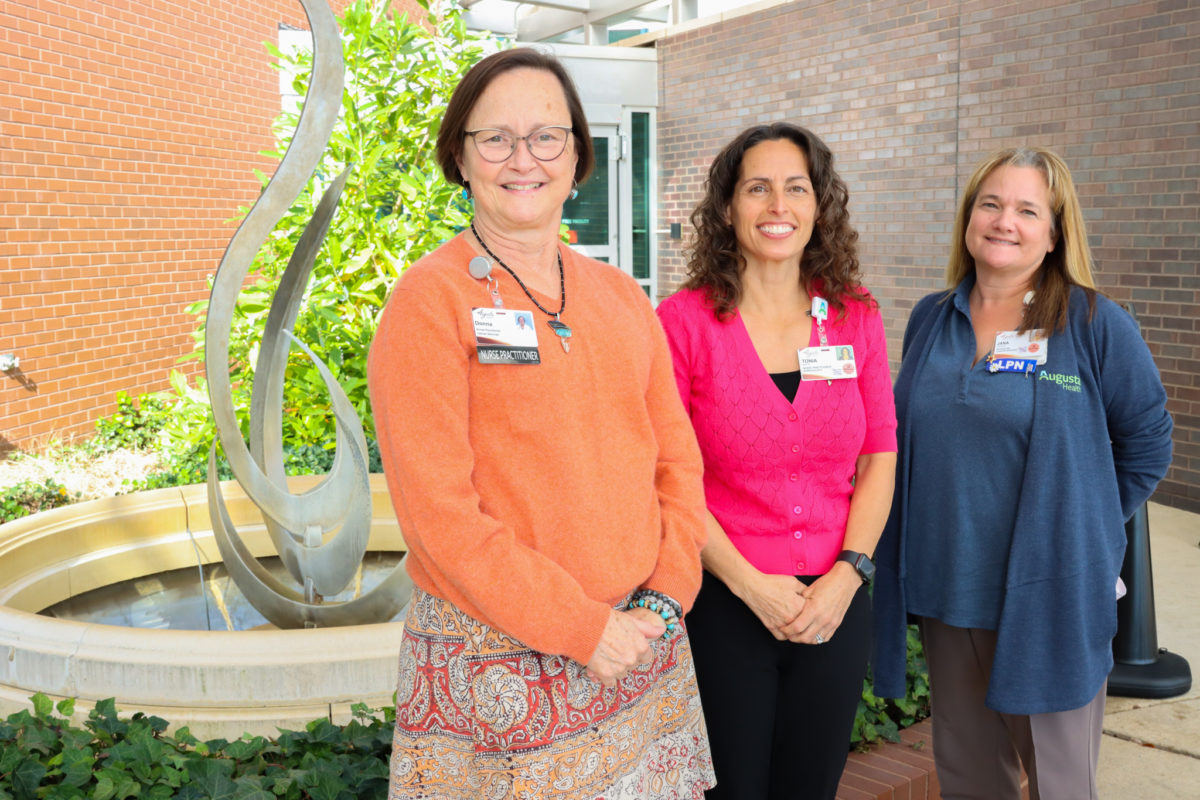Do You Have What It Takes to Reduce Your Cancer Risk?

Date: December 6, 2022
Categories: Health Focused, Cancer
Jana Marshall, LPN, Genetics Navigator
Tonia Markel, RN FNP-c
Donna M. Westermann, RN ACNP-cs
The first step in answering that question is to understand your risk. Augusta Health’s Cancer Risk Assessment and Prevention Program offers people the opportunity to explore and understand their personal answers to this question.
Cancer Facts and Figures, 2022 (a publication of the American Cancer Society) reports an estimated 1.9 million new cancer diagnoses in the US this year. It goes on to report, 42% or 805,600 cases are potentially avoidable, including 19% of cancers caused by smoking and at least 18% caused by a combination of excess body weight, alcohol consumption, poor nutrition, and physical inactivity. Lifestyle, the environment, family, and heredity all play a role in cancer risk.
Everyone is at risk of developing cancer. The degree of risk depends upon one’s age, family history, hereditary factors, and lifestyle. Family history plays an important role in the assessment of cancer risk. As the holidays approach and families prepare to gather, it’s a great time to ask parents, grandparents, aunts, and uncles about the family history of cancer. Noting details including the age at cancer diagnosis and the type of cancer one has influences consideration for possible genetic testing. Some cancers “seem to run in families” and others have an outright genetic connection. Meaning a gene that normally is protective against cancer is altered in a way that reduces its function and increases the risk of cancer in an individual and potentially their children. When similar cancers occur in several generations in a family, it’s time to ask questions about heredity and the possibility of passing an ineffective gene along that can predispose or elevate cancer risk. While we can’t change our genes, identifying individuals at increased cancer risk allows us to offer to screen differently than those at average risk. Early or more frequent screening allows us to prevent or identify cancers when they are most treatable and likely curable.
Lifestyle is the one factor a person can modify to reduce their cancer risk. Examining and modifying one’s lifestyle is the most meaningful and controllable way a person can influence their cancer risk.
Tobacco use remains the most preventable cause of cancer occurrence and death in the United States. Cigarette smoking increases the risk of at least 12 cancers, including the mouth and throat, lung, esophagus, pancreas, cervix, kidney, bladder, stomach, colon and rectum, liver, and acute leukemia. Other tobacco products, including cigars, pipes, water pipes, e-cigarettes, and smokeless tobacco all contribute to overall cancer risk. Secondhand smoke also contributes to increased cancer risk. There is no safe level of exposure to secondhand smoke.
Alcohol consumption increases the risk for cancers of the mouth, throat, esophagus, liver, colon and rectum, female breast, and stomach. Cancer risk increases with alcohol volume. Even a few drinks per week may increase the risk of some cancers.
Maintaining a healthy body weight, consuming a healthful diet, and being physically active are the most effective personal strategies for reducing the risk of cancer. The American Cancer Society 2020 Guidelines on Diet and Physical Activity for Cancer Prevention advises the following:
- Achieve and maintain a healthy body weight throughout life
- Be physically active: Adults should engage in 150 to 300 minutes of moderate-intensity physical activity per week, or 75 to 150 minutes of vigorous-intensity physical activity. Children should engage in at least 1 hour of moderate or vigorous activity daily.
- Follow healthy eating patterns, which include:
- Foods that are high in nutrients to achieve and maintain a healthy body weight
- A variety of vegetables-dark green, red, and orange; fiber-rich legumes (beans and peas) – 5 to 6 servings per day
- Fruits, especially whole fruits with a variety of colors
- Whole grains
- Healthy eating pattern limits or does not include:
- Red and processed meats
- Sugar sweetened beverages
- Highly processed food and refined grain products
- It is best not to drink alcohol. People who do choose to drink alcohol should limit their consumption to no more than 1 drink per day for women and 2 drinks per day for men.
Lifestyle changes always involve personal commitment, motivation, and discipline to successfully achieve the desired outcome. If you think you are at an increased cancer risk based on lifestyle, family, or personal history and you wish to explore this further, please discuss it with your family provider or consider a referral to our Cancer Risk Assessment and Prevention Program. For more information, please visit augustahealth.com/service/genetic-risk-assessment/ or call 540-245-7145.
Additional American Cancer Society resources:
Guidelines for cancer prevention:
Guidelines for cancer survivors: cancer.org/healthy/eat-healthy-get-acticancer.org/health-care-professionals.american-cancer-society-prevention-early-detection-guidelines/nupa-guidelines-for-cancer-survivors.htmlve/acs-guidelines-nutrition-physical-activity-cancer-prevention/guidelines.html
